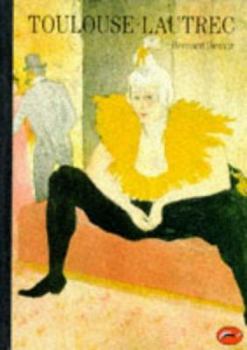Toulouse-Lautrec
(Part of the World of Art Series and World of Art Series)
An account in the WORLD OF ART series of the achievements of Henri de Toulouse-Lautrec, as a graphic artist and as a painter, in which the author examines all the major influences on his life and... This description may be from another edition of this product.
Format:Paperback
Language:English
ISBN:0500202508
ISBN13:9780500202500
Release Date:July 1991
Publisher:Thames & Hudson
Length:216 Pages
Weight:1.05 lbs.
Dimensions:0.6" x 5.9" x 8.3"
Customer Reviews
1 rating
Looking at the art in the mirror
Published by Thriftbooks.com User , 22 years ago
In "Contre Sainte-Beuve," French novelist Marcel Proust separated art from private life. But Henri TOULOUSE-LAUTREC drew on what interested him in art and life, that is, personality through how the model looked and stood: Edgar Degas- and Edouard Manet-type young girl down in the dumps in "La gueule de bois"; his first large-scale dance scene figures in "Un coin du Moulin de la Galette"; model Suzanne Valadon in 3/4 profile with a Vincent Van Gogh-type turban and in the Camille Pissarro-type "Poudre de riz" front portrait; and Jean Antoine Watteau- and Degas-type popular entertainer Jane Avril, without facial details but immediately recognizable by her shoes with bows, stage stance, and tilting shoulders in an all-blue composition except for the yellow-splashed meeting between knees and skirt. With his Paul Gauguin- and Van Gogh-type expressive color areas, he was hard to beat: "L'anglais au Moulin Rouge" lithographing girlish brightness against black, blue, his favorite olive green, purple, red, and yellow; "Le dernier salut" in flat and narrowly ranged blue, purple and yellow, with a Chat Noir Chinese theater-type hearse driver and hired mourners profiled in black; his Moulin Rouge poster, dark violet from richly mixed black, blue, and red scatter sprayed over each other from a heavily charged brush through a sieve, with the foreground figure slightly sinister and the background dancer in gold, pink, and white; his rare landscapes, light in small-scaled and lively colored freshness, playing early Pissarro- and Alfred Sisley-type light and shade; "Routy" put together Frans Hals-style, with Manet-type expressive blacks and lightly sketchy brushwork; his stained glass window for Tiffany's, sketched and designed from Japanese-style ballet dancers around a water lily-covered lake; and "Un examen a la faculte de medecine de Paris," just over a month before he died, in sombre black and green brightened in the window light by a red academic gown and white writing paper and with Honore Daumier-type accurate draughtsmanship and confident brushwork. He applied his Manet-type dramatic profiles and simplified color areas to subjects from a Degas-type working woman's world: "A la toilette" linking the sitter's auburn hair to a mosaicized background and the pale blues of her dress to what was on her dressing table and her shelf, for a heavily downward brushstroked, overall melancholy; "Au Moulin Rouge," with Gustave Caillebotte-type diagonals for depth and with Degas-type cropped snapshot-style lighting from below to bring out a girl's masklike face; and "Au salon de la rue des Moulins," with one girl seen from the back cut off, Japanese- and snapshot-influenced Impressionist style, by the canvas edge. His post-Impressionist color and style lasted into the twentieth century, among others, in the accent diagonals on Edvard Munch's horizontally-shaped program for Jean Gabriel Borkman's acting a Henrik Ibsen play at Theatre de l'oeuvre; blue period color and for




